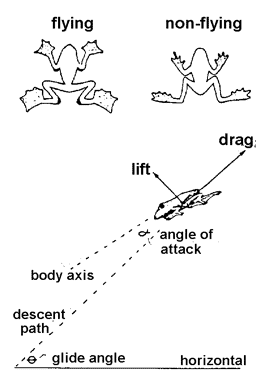 |
Science Frontiers ONLINE No. 76: Jul-Aug 1991 |
|
|
Flying, parachuting, and falling frogs
 (Top) Shapes of flying and non-flying frogs. (Bottom) Aerodynamic diagram for a flying frog. |
"This paper reports an examination of the shift from aboreal to 'flying' frogs where we evaluate the the aerodynamic performance consequences of both a behavioral and morphological change. 'Flying' frogs have evolved independently several times among the 3,400 species of anurans. Although the particular nonflying sister species to each flying form remains unknown, in all cases flyers are distinguished from related, nonaerial, aboreal frogs by a similar suite of morphological characters: enlarged hands and feet, full webbing on the fingers and toes, and accessory skin flaps on the lateral margins of the arms and legs. 'Flying' frogs are not capable of powered flight, but do travel considerable horizontal distances during vertical descent. They are technically classified as gliders because they can descend at an angle less than 45� to the horizontal. Interestingly, aboreal frog species lacking particular morphological specializations (= nonflying frogs) drop from vertical heights as well. These animals descend at glide angles greater than 45� and are, by definition, parachuting."
(Emerson, Sharon B., and Koehl, M.A.R.; "The Interaction of Behavioral and Morphological Change in the Evolution of a Novel Locomotor Type: 'Flying' Frogs," Evolution, 44: 1931, 1990.)
Reference. Our "biology" compendium Incredible Life contains many articles on biological anomalies. To order, see: here.